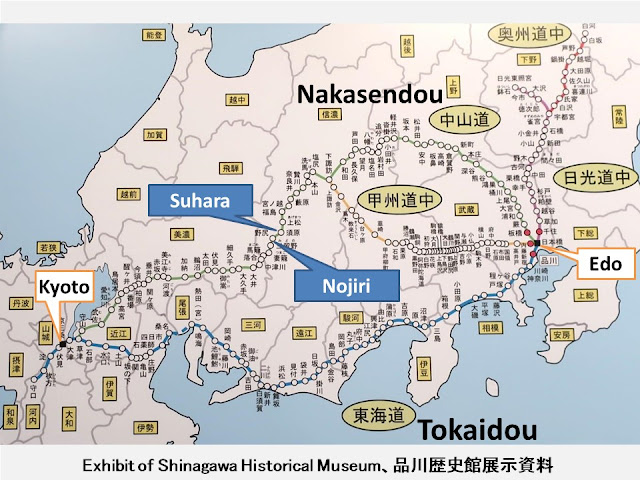Forest occupies 96% of Okuwa village in Kiso region of central Japan. Its important industry has been forestry. Okuwa people grow high quality trees and provide timbers to Ise Shrine (the highest-ranking shrine). Many articles which were used in the village are displayed. We can take photo except for the special exhibition room.
木曽路にある大桑村は、その面積の96%が森林、林業の村です。伊勢神宮の御用材も提供しています。資料館には村で使われていた様々な品が展示されています。特別展示室を除いて撮影可能です。
Exhibits on the left are forestry tools. The timber on the right is made of Nezuko which is one of five kinds of Kiso trees. Nezuko is light, hard and water resistant; I found Nezuko geta (Japanese wooden sandal) at souvenir shops.
左は山仕事の道具、右下は木曽五木のひとつ「ねずこ」です。土産物店では、ねずこ下駄が売られていました。軽く、堅く、水に強い木曽の名産です。
Everyday goods in the early 20th century are displayed. Although wooden skis and sled are exhibited, I couldn’t find typical utensils which were used in mountainous area. I reckon the way of life became similar across Japan.
大正、昭和の生活用品が並びます。山間部らしさを感じるものは、木製のスキーやソリだけでした。全国的に同じような生活になっていたのかもしれません。
The hanging scroll of the silkworm culture deity is exhibited in sericulture section above. There is a deity in respective industry and people pray to it. It’s very Japanese!
養蚕の用具のコーナーには、蠶養大神の掛け軸があります。それぞれの仕事に神様がいて、祈るのが日本人ですね。
Road and inn、道と宿
There were eleven post-towns in Kiso region, and two of them were in Okuwa village. I’ll show you later.
大桑村には、中山道木曽11宿のうち、須原宿と野尻宿がありました。
Those are utensils in the late 19th century. All items at the front row are lunch boxes. The one at left end is a theatergoing bento box. It’s a fun time to have lunch outside.
江戸時代、明治時代の生活用品が展示されています。左下の箱の名前は、芝居弁当。手前一列はすべて弁当箱です。弁当を広げる時間は楽しい時間ですね。
The pail in center was used at a liquor shop. Only skillful craftsman would make it. The cutting boards on the left were prepared to make a meal for a young lady of noble birth in 1849. She stayed at Nojiri post-town on the way to Edo (old name of Tokyo) to get married with the shogun. The cutting boards remained at the inn. Old goods have its story.
中央は、酒の小売りに使われた変形桶。器用に作りますね。左の大まな板は、1849年に一条家の姫が13代将軍家定の継室として下向したときに取り揃えられたもの。払い下げてもらい、野尻宿・脇本陣の木戸家に伝わりました。品物には、それぞれの歴史がありますね。
The article in center is a New Year’s decoration which is named “daikon (Japanese white radish)”. People prayed for rich harvest and fire prevention.
中央は「大根」とよばれる小正月の飾り物です。餅を木の枝に刺した繭玉とともに飾り、豊作や火難逃れを祈願しました。
Suhara post-town、須原宿
The curving road at the center of the post-town exudes a certain atmosphere of the old highway (Nakasendou).
続く道と宿場らしい曲がりがいい雰囲気です。
The watering-place is called “mizu (water) bune (boat)”. Residents and travelers have used it.
水が豊富で、街角の水舟を皆さんが利用しているようです。
The photo above is the ex-inn “Kashiwa-ya” at the south end of the town. The signboard meant that the inn was a member of a reliable inn association “Santo (three megalopolises) kou”. A man in Osaka was the leader and a man in Edo and a man in Kyoto were local organizers. A member of the association looked for the crest (military leader's fan) at the top of the board in order to stay at the affiliated inn.
宿の南端には、旅籠だった「かしわや」さんがあります。三都講という看板が上がっています。講元は大阪、江戸と京都に世話方がいますね。講のメンバーは、軍配を目印に宿を探しましたのですね。
Nojiri post-town、野尻宿
The road in Nojiri is also winding. It was planned to delay enemy’s march.
七曲がりで外敵を防御した宿場町でした。
The name of the building is “Hazure”, or literally "edge". It is at the west end of the town. Nojiri is not a tourist attraction. However, a local said that foreigner travelers sometimes walk from Tsumago post-town which is one of the most popular tourist destinations for foreigners.
この家の屋号が「はずれ」。宿場の西の外れ(西端)という意味です。観光地化していませんが、地元の人によると、妻籠からの外国人が歩いて通るとのことでした。味がある道です。
Official
website of the museum: https://www.vill.okuwa.lg.jp/kyouiku/kyouiku/rekishiminzoku_shiryoukan.html
(in Japanese)
Visited in March, 2024
Previous post (museum at the foot of Mt.
Ontake): Sato Terrace Mitake (Kiso Town Mt. Ontake Visitor Center) 、さとテラス三岳(木曽町御嶽山ビジターセンター)
Next post (museum in the neighboring town which is famous for Tsumago post-town): Nagiso-machi Museum in Tsumago (1/2)、南木曽町博物館(part1)














Comments
Post a Comment